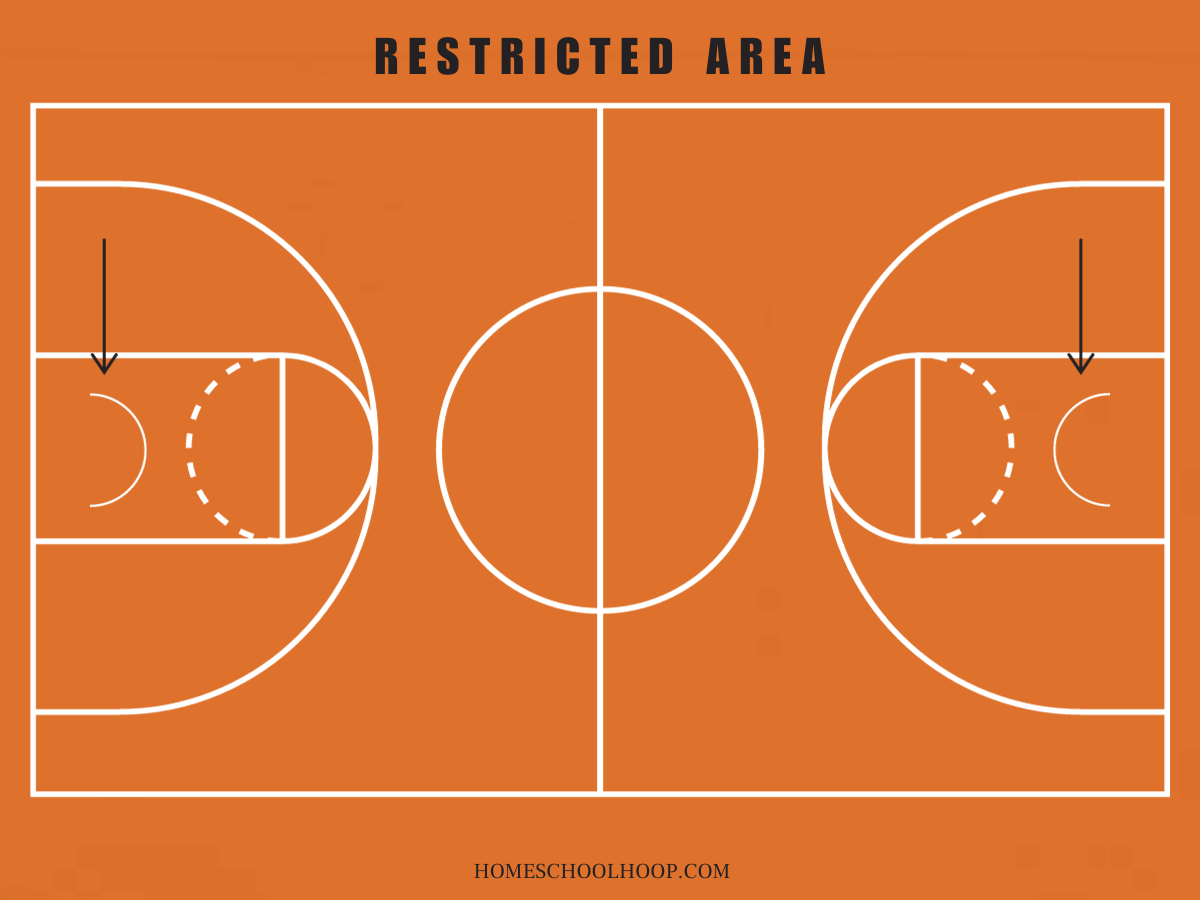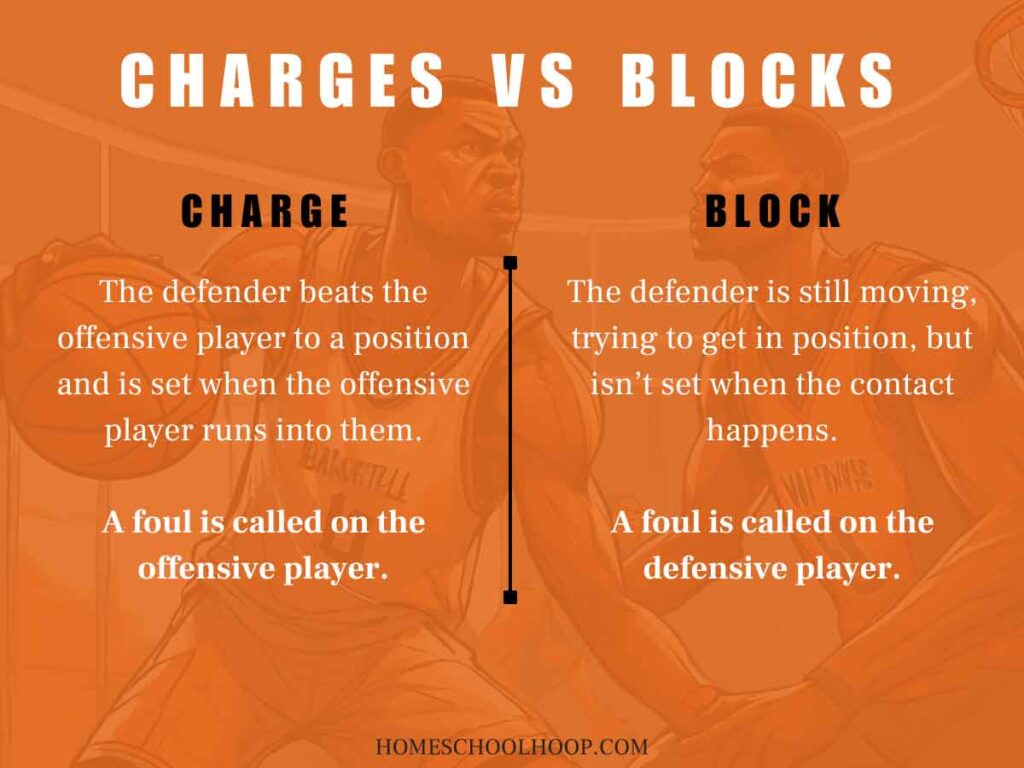Key takeaways:
- A charge in basketball happens when a player trying to score runs into a defender standing still.
- A charge call results in a personal foul against the offensive player.
- When a defender successfully “takes the charge,” their team gets the ball.
Imagine you’re watching a basketball game. Suddenly, a player holding the ball crashes into another player who isn’t moving, and the referee blows the whistle. This moment could swing the game one way or another. What you’ve likely just seen is a charge.
A charge isn’t just any bump or collision in a game; it’s a deliberate move by the defending player. They have to stand in the right spot, at the right time, without moving, and be ready for the hit. It’s a smart way to turn the tables and get the ball for their team.
Knowing about charges is key for everyone on the court and watching the game. It can change the score, shift who’s in control, and make or break a game’s result. Now, let’s break down what a charge in basketball is and how it differs from other types of fouls.
Definition of a Charge in Basketball
A charge is a rule that helps determine the proper position a defensive player must be in to defend an offensive player driving to the basket properly. Here’s a deeper look at what constitutes a charge:
- It’s about position and timing: For a charge to be called, a defender must set themselves in the offensive player’s path before that player starts their shooting motion.
- Location matters: To draw a charge, the defender must be outside the restricted area, the semi-circle beneath the basket. If they’re inside this area, it’s not a charge.
Let’s break this down further. A charge occurs when a defender stands their ground and the offensive player, moving with the ball, runs into them. The key is that the defender must have established their position first. They can’t be moving into the offensive player’s path as the contact happens; they need to be already there, set and waiting. This means the defender has to anticipate where the offensive player is going and get there first.
Kyle Lowry, one of the shortest NBA players today, is one of the best at taking charges (although some think he’s the biggest flopper in the NBA).
Results of a Charge Call
When a referee calls a charge, it affects the game in two significant ways:
- Foul on the Offensive Player: The player who ran into the defender gets a personal foul, adding to their total count.
- Change of Possession: The game pauses briefly, and the defending team gets control of the ball.
A charge in basketball is a way for defenders to use strategy and quick thinking to gain an advantage. When done right, it shifts the game’s momentum, giving the defending team a chance to score and potentially changing the game’s outcome.
What to Know About the Restricted Area

For the referees to call a charge, the defender must be outside the restricted area close to the basket. This small arc is like a no-charge zone. The charge won’t be called if the defender’s feet are inside this area when they take the hit. This area ensures defenders can’t just camp under the basket to draw charges easily.
Learn more: How many players are on a basketball team?
Charge Vs. Block: Understanding the Differences
The charge in basketball is often confused with the block call. Both involve a collision between a defender and an offensive player, but their difference lies in the defensive player’s positioning.
A charge is an offensive foul and a block is a defensive foul.
Here’s a simple way to understand them:
- Charge: This happens when an offensive player runs into a defender, already in position and not moving. The foul is called on the offensive player.
- Block: This is called when the defender is still moving to get into position and hasn’t fully stopped when the collision occurs. The foul is called on the defensive player.

Why it matters:
- Different Outcomes: A charge means the offensive player gets a foul, and the defending team gets the ball. A blocking foul in basketball means the defender gets a foul, potentially leading to free throws for the offense.
- Game Strategy: Players need to know these differences. Knowing when to stand firm (to draw a charge) or when to avoid contact (to prevent a block) can change the game’s flow.
Learn more: How many fouls to foul out in the WNBA?
Techniques and Strategies to Draw a Charge
Drawing a charge in basketball is a skill that requires practice and awareness. Here are some techniques and strategies players use to draw a charge successfully:
- Anticipate the Play: Good defenders read the game. They predict where the offensive player is heading and move there first. Watching game footage to get to know your opponent’s tendencies can also be helpful in understanding when to go for charges.
- Positioning is Crucial: Make sure you’re outside the restricted area under the basket. Your feet should be set, and you should be stationary before the offensive player makes contact.
- Stay Sharp: React quickly to your opponent’s movements, , but commit to it once you’ve chosen your spot.
- Body Control: When taking the hit, keep your body controlled. Falling too dramatically can lead to either a blocking call of flopping in basketball call instead.
- Practice Makes Perfect: Like any skill, drawing a charge takes practice. Work on your timing and positioning in training sessions.
How to Avoid a Charge Call in Basketball
Avoiding a charge call in basketball is as important as knowing how to draw one. Here are some straightforward tips for offensive players to steer clear of charge calls:
- Keep an Eye on Defenders: Always keep an eye on how defenders are positioned. This helps you anticipate their moves and avoid running into them.
- Manage Your Speed: Rushing to the basket is tempting, but if you stay controlled and use hesitations and quick bursts of speed, it’s tougher for defenders to predict your move and set up a charge.
- Practice Stopping and Changing Direction: In the same vein, quickly stopping or changing direction can help you avoid crashing into a defender set up for a charge.
- Use Pump and Pass Fakes: A well-timed fake can cause a defender to commit to a position early, giving you a clear path and lowering the chance of a charge.
- Know Your Opponent: If your defender is faster and can get into position quickly, think about other ways to contribute offensively, like passing or shooting, instead of driving to the basket.
Learn more: What is traveling in basketball?
FAQ
What is considered a charge in basketball?
A charge is when an offensive player with the ball collides with a stationary defender who has established their position. The defender must be set before the contact and outside the restricted area under the basket.
How do you get a charge in basketball?
A defender gets a charge by positioning themselves in the path of an offensive player, standing still with their feet set, and taking the hit. They must be outside the restricted area and in place before the offensive player makes contact.
How does charging in basketball impact the game?
Charging can shift the game’s momentum. It results in a turnover in basketball, giving the ball to the defending team, and adds a personal foul to the offensive player, impacting their play and strategy.
Is an offensive foul and a charge the same thing?
A charge is a type of offensive foul. While all charges are offensive fouls, not all offensive fouls are charges. Offensive fouls can also include illegal screens or pushing off defenders.
What are the consequences of a charge call in basketball?
A charge call results in the offensive player receiving a personal foul and a turnover, with the defending team gaining possession.
How do you avoid charges in basketball?
Avoid charges by being aware of defenders’ positions, controlling your speed, practicing quick stops and direction changes, using fakes, and understanding your matchup with the defender.
Is a charge a team foul?
Yes, a charge counts as a team foul. It contributes to the team’s total foul count, leading to penalty situations like bonus free throws for the opposing team.


